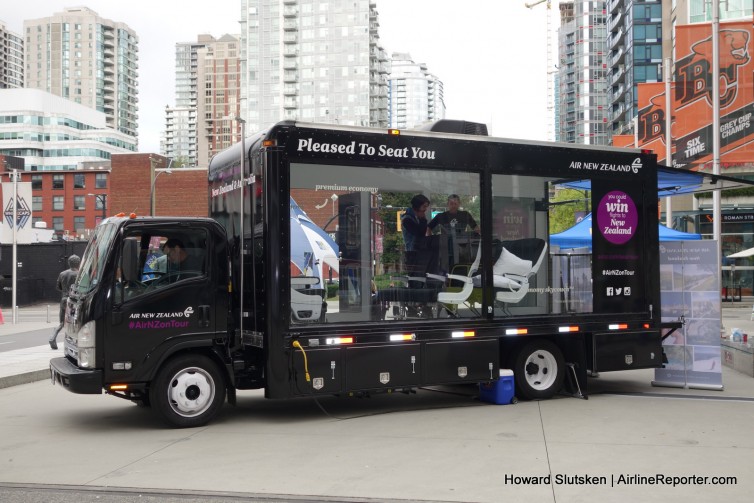
Air New Zealand’s “Pleased to Seat You” truck on display in Terry Fox Square in Vancouver
Air New Zealand is in the midst of refurbishing its Boeing 777-200ER fleet, and is showcasing the planes’ new Premium Economy and Economy Skycouch seats during a North American ’œPleased to Seat You’ tour.
The seats are on display in a 26 foot, 5 ton, glass-walled truck that will cover more than 7,000 miles, giving the public a chance to see and sit in the -200’s new seats. The airline introduced the innovative Skycouch in its Boeing 777-300s ’“ the footrest in a row of three seats can be positioned at the same height as the seat cushions, giving a flexible space for passengers.
With the update of the -200s, all of the long-haul aircraft in Air New Zealand’s fleet will include the Skycouch, along with the new Premium Economy seats also found in its Boeing 787-9s.

So you need to book some flights and you hit the usual suspects online to find the best prices: Kayak, Orbitz, Travelocity or even Fare Compare. But when you look at the results, it is all about the price and you are not told the whole story. The other sites don’t tell you what seats are like, what snacks or drinks you may expect or what fees you might be charged for who knows what. Things are now changing with RouteHappy.com, which puts Passenger Experience (#PaxEx) into the equation.
Routehappy takes what the old Metasearch websites (like Kayak) did by aggregating all the flight prices into the one site, but it takes it one step further. For some flyers, price is everything. But for many of us, we are willing to pay for some of the nicer things. Routehappy calls these ’œHappiness Factors’.
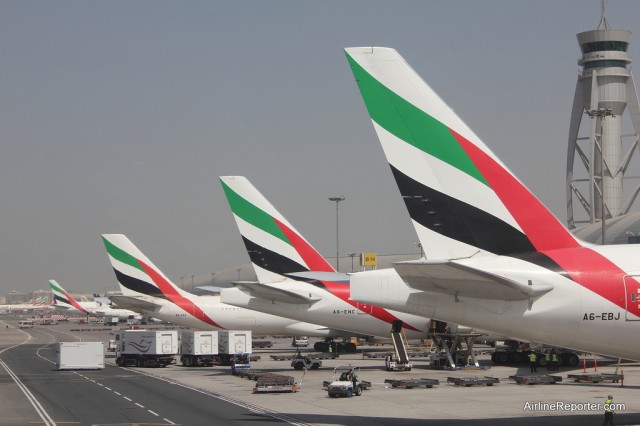
Line of Emirate’s tails in Dubai.
Recently, I had the ability to ask Patrick Brannelly, Emirates Airline Vice President – Corporate Communications, Product, Publishing, Digital & Events, some questions about Wi-Fi and the future of entertainment on the airline. Here is our discussion:
AirlineReporter.com (AR) How many Emirates aircraft currently have Wi-Fi available?
Patrick Brannelly (PB): The whole A380 fleet (currently 21 aircraft) has Wi-Fi. We’ll be getting another 10 A380s before the end of 2012 and they’ll all have Wi-Fi as well. We’ll also be introducing the ability to use your own mobile phone next month on our A380s ’“ a service that we already have on over 90 of our other aircraft (we launched that service in 2008).
AR: What is the schedule for the entire fleet to be fitted?
PB: Going forward, all A380s will have the service and we aim to start fitting the rest of the fleet with internet before the year end. It will take some time to equip the entire fleet but we are working on accomplishing this as quickly as possible.
AR: Are new Airbus/Boeing aircraft equipped with the Wi-Fi?
PB: Yes for our A380s and we hope to have our Boeing 777s equipped from mid-2013.
Why did Emirates choose OnAir?
OnAir was the only option offered by Airbus for equipping the A380 fleet straight out of the factory ’“ they have provided a good service and we are happy with them.
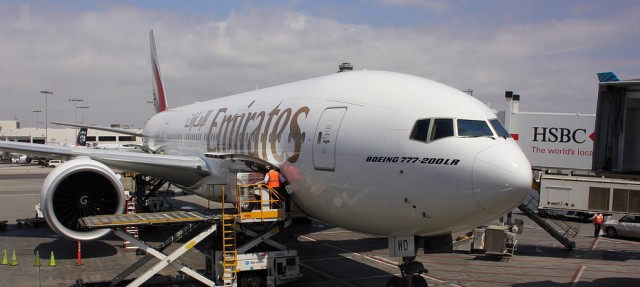
Emirates plans to install Wi-Fi to their 777 fleet in the future.
AR: Currently, Wi-Fi pricing is set up based on the amount of data used and how do passengers patrol/control the amount of data used?
PB: Customers buy a package of data, either 5MB or 30MB for mobile or 30MB/100MB for laptops. They can see their current usage and decide whether to buy extra MB or cut off at the limit.
AR: Is Emirates looking at offering an unlimited plan?
PB: The above packages are often more than most people need during their flights. Over two thirds of passengers use less than 20MB and only 1.6% of passengers use more than 100MB.
AR: A recent APEX story shows the record being at 680MB, has that been broken yet?
PB: It’s still a record ’“ 680.51MB was used on our New York flight on Valentine’s Day. Someone in love perhaps!
AR: What is the current pricing structure?
PB: We may tweak this pricing in time, but currently users can connect a mobile from as little as $2.75 for 5MB of data. This is more data than most will need to connect socially throughout even a long flight. We also have a heavy (30MB) mobile package available for $15 but few opt for it. Laptops can connect from as little as $5, and there is a heavy user package for $15 for 100MB. These prices are low for satellite connectivity, but we see this as a service to our customers rather than a profit centre (in fact we lose money).
AR: What are the usage statistics? Is there growth?
PB: Yes ’“ we are still seeing growth. This is probably because awareness is still growing about the service and because increasing numbers of people are carrying on devices that can connect. We see over 4% of passengers connect on the very long flights of over 12 hours (such as New York / Sydney etc.) but much less on flights under 5 hours (less than 1.5%).
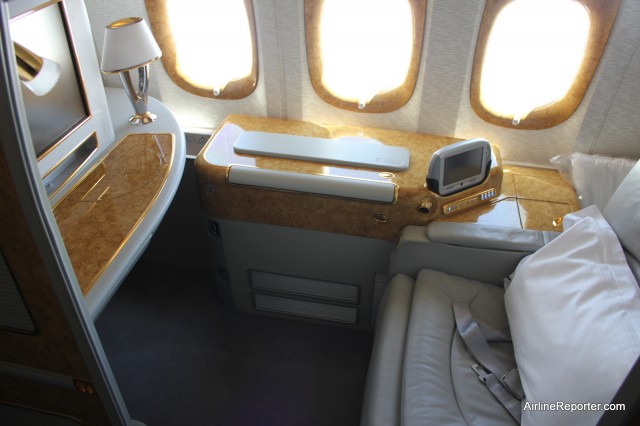
Emirates already offers a pretty slick product. Adding Wi-Fi will only make it better. This is First Class seen on a Boeing 777.
AR: Are there any plans to offer on-board Wi-Fi entertainment options (where passengers can access Emirates entertainment from their personal devices via Wi-Fi)?
PB: We are looking at all options ’“ but with over 1,300 channels of the latest and greatest entertainment available on your large screen personal TV for every Emirates customer, the need to play media on your own device is reduced.
AR: Will passengers be able to access the internet through ice (the name for the entertainment system)?
PB: We hope so but not at the moment. There are some technical issues, largely to do with the seatback’s light-browser’s capability to connect to the internet for a good experience. You really need a mouse and a keyboard at the moment and that’s not practical. However, we are working on it.
AR: Are there dark spots where passengers will not be able to have internet?
PB: The OnAir service uses Inmarsat’s geo-stationary I4 satellites which cover the entire globe except for the extreme poles (above about 80 degrees). There are also a few countries that are yet to provide approval to use the service in their airspace, so we have to block it… but these are reducing.
AR: What digital “wonders” from Emirates can passengers expect for the future?
PB: Emirates has led technology in the air for 20 years or more. From being the first airline to install TVs on every seat on the entire fleet in 1992 to today, when we’ve introduced services such as mobile phones and internet inflight, as well as large HD capacitive touch screens onboard our latest 777s. Rest assured we have a lot more innovation coming, but we tend to talk about it when it’s ready to launch rather than before’¦
RELATED EMIRATES AIRLINE STORIES:
* Inside the Emirates Flight Catering facility in Dubai
* Emirates First Class Lounge Review in Dubai
* My Review: Flying Emirates Airline Business Class to Dubai
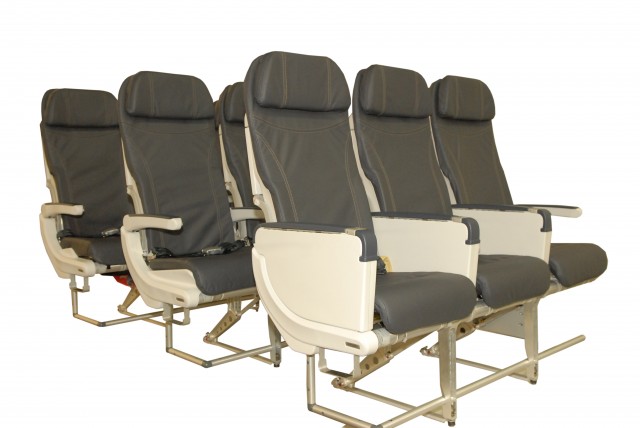
Alaska Airlines new New Recaro seats for economy class that will make their appearance on the airline's new Boeing 737-900ERs. Image from Alaska.
Alaska Airlines has announced that they will be installing new seats from Recaro Aircraft Seating on their 22, soon-to-be delivered, Boeing 737-900ERs.
The seats will offer a six-way adjustable headrest, three inches of recline and an additional inch of legroom.
The additional leg room will not affect the airline’s seat pitch of 31-32″, but it will offer more room for your legs. “The extra inch we refer to is gained by Recaro’s clever design that effectively adds one more inch of room to your living space, without us moving the seats further apart,” Alaska spokes person confirmed to AirlineReporter.com. “Specific to pitch, our pitch will stay consistent with our current standard 31-32 inches.”
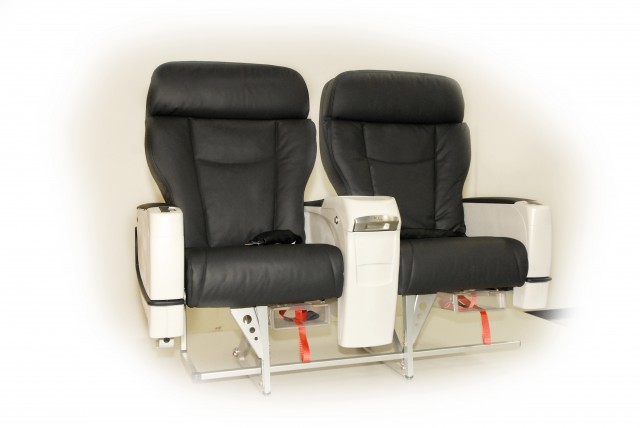
Alaska Airlines new New Recaro seats for First Class that will make their appearance on the airline's new Boeing 737-900ERs. Image from Alaska.
Alaska will also get new Recaro seats for the first class cabin that will offer five inches of recline, an articulating seat bottom and a six-way adjustable headrest.
The seat, “design includes a comfortable yet slimmer seatback and bottom and a literature pocket located above the tray table,” said Joe Sprague, Alaska Airlines’ vice president of marketing. “The new seats add to a very special onboard experience that all of our customers flying Alaska’s new 737-900ERs will enjoy, including Boeing’s Sky Interiorwith its improved lighting and sculpted overhead bins that create a more spacious cabinonboard Wi-Fi, Starbucks coffee, premium Washington wines and delicious meals for purchase, as well as our renowned personal service.”
The seats are also lighter and are expected to save about 8,000 gallons of fuel annually per aircraft.






